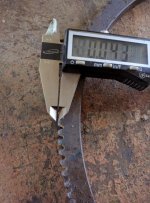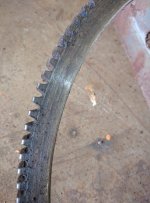JasonPAtkins
Hot Rolled
- Joined
- Sep 30, 2010
- Location
- Guinea-Bissau, West Africa
I'm a novice gear-er, having only dealt with calculating such things once in the past, in order to fix a lathe feed gear.
The short story is that I'm trying to introduce a roughly 10:1 reduction into a mortar mixer. I'm helping set up a factory over here to make drinking water filters to help with the many waterbourn diseases that give people chronic diarrhea. The mixer is spinning too fast for the clay/sawdust/water mixture we use to make the ceramic water filters. Rather than getting the mixture to ball up and roll over and over, it just smears the clay against the wall of the pan, packing it denser and denser with every revolution, until it eventually stalls. We may also need to change the mixer paddle geometry, but by watching videos of other factories around the world making these same kind of affordable ceramic water filters, we know they're successfully mixing closer to 6rpm rather than the 60rpm we're getting.
The current solution is not the best one available. I admit that, but ask for your help anyway. An enclosed worm gear reduction unit would be much more appropriate, much tougher, and last a lot longer. I don't have a way to get one of those right away. Perhaps if this solution works for a year or two, that will be the proof of concept and give us time to send the worm drive over.
The current mixer "gear train" is: Honda gas engine with some reduction built into it -> dual belt sheave pair -> pinion gear to big gear pair -> mixer paddle shaft.
Mixer diagrams for this model are here, in case that explanation isn't clear.
I'm proposing to add an intermediate shaft on pillow bearings that would change the arrangement to be this: Honda gas engine with some reduction built into it -> dual belt sheave pair -> small 14 tooth 12DP gear to 144 tooth 12dp gear ->pinion gear to big gear pair -> mixer paddle shaft.
If I order it today from Amazon, I can buy the 14 tooth gear and have visitors bring it with them next week. It's small. The big one, they won't have weight for. Fortunately, I found this little gem at the scrap yard a year ago and grabbed it, assuming a project like this might come along eventually.

Machining the hub doesn't seem too tough, and I have a 1/4" push broach, so I'm planning on a turning a hub with 1" ID, 2.5" OD, plasma cutting a piece of plate with a 2.5" ID and 10.75" OD, and welding the three together.
So, I have one chance to order the matching 14T gear!
The scrap-yard gear ring is 144T. It mics at 12.080" for an OD. Using DP=(T+2)/OD gives DP=146/12.080=12.086DP. Obviously, that's not right. So, I'm left with two choices: 1) The gear teeth are a bit worn, or 2) it's a metric module gear.
In support of idea #1:
To make it a clean 12DP, the OD would have to be OD=(T+2)/DP=146/12=12.166" OD. That would mean half the difference of wear, =(12.166-12.080)/2)=.043" of wear on each side. Given the following photo, I think I might be able to believe that.

In support of #2:
The gear is exactly 12.00mm wide, so it's either an imperial/metric mutt, or the teeth are metric to match the face width.
However, the calculations there would be MOD=(T+2)/OD=146/306.832mm (measured)=0.475MOD. That's not standard. To make it a standard 0.5MOD gear, it would have to be OD=(T+2)/MOD=146t/0.5mod=292mm=11.496" or for 0.4MOD, OD=(T+2)/MOD=146/0.4MOD=365mm OD=14.37". Obviously, it's far from either of those.
Given that, it seems most logical to assume it's a slightly worn 12DP gear that happens to be a metric mutt, having a 12mm face width, does it not?
-----------------
Second issue is pressure angle. 14.5 degree is the stubbier, right, and 20 is the pointier? If so, I have to vote for this being 14.5, and even then a bit worn. Seem logical?

The short story is that I'm trying to introduce a roughly 10:1 reduction into a mortar mixer. I'm helping set up a factory over here to make drinking water filters to help with the many waterbourn diseases that give people chronic diarrhea. The mixer is spinning too fast for the clay/sawdust/water mixture we use to make the ceramic water filters. Rather than getting the mixture to ball up and roll over and over, it just smears the clay against the wall of the pan, packing it denser and denser with every revolution, until it eventually stalls. We may also need to change the mixer paddle geometry, but by watching videos of other factories around the world making these same kind of affordable ceramic water filters, we know they're successfully mixing closer to 6rpm rather than the 60rpm we're getting.
The current solution is not the best one available. I admit that, but ask for your help anyway. An enclosed worm gear reduction unit would be much more appropriate, much tougher, and last a lot longer. I don't have a way to get one of those right away. Perhaps if this solution works for a year or two, that will be the proof of concept and give us time to send the worm drive over.
The current mixer "gear train" is: Honda gas engine with some reduction built into it -> dual belt sheave pair -> pinion gear to big gear pair -> mixer paddle shaft.
Mixer diagrams for this model are here, in case that explanation isn't clear.
I'm proposing to add an intermediate shaft on pillow bearings that would change the arrangement to be this: Honda gas engine with some reduction built into it -> dual belt sheave pair -> small 14 tooth 12DP gear to 144 tooth 12dp gear ->pinion gear to big gear pair -> mixer paddle shaft.
If I order it today from Amazon, I can buy the 14 tooth gear and have visitors bring it with them next week. It's small. The big one, they won't have weight for. Fortunately, I found this little gem at the scrap yard a year ago and grabbed it, assuming a project like this might come along eventually.

Machining the hub doesn't seem too tough, and I have a 1/4" push broach, so I'm planning on a turning a hub with 1" ID, 2.5" OD, plasma cutting a piece of plate with a 2.5" ID and 10.75" OD, and welding the three together.
So, I have one chance to order the matching 14T gear!
The scrap-yard gear ring is 144T. It mics at 12.080" for an OD. Using DP=(T+2)/OD gives DP=146/12.080=12.086DP. Obviously, that's not right. So, I'm left with two choices: 1) The gear teeth are a bit worn, or 2) it's a metric module gear.
In support of idea #1:
To make it a clean 12DP, the OD would have to be OD=(T+2)/DP=146/12=12.166" OD. That would mean half the difference of wear, =(12.166-12.080)/2)=.043" of wear on each side. Given the following photo, I think I might be able to believe that.

In support of #2:
The gear is exactly 12.00mm wide, so it's either an imperial/metric mutt, or the teeth are metric to match the face width.
However, the calculations there would be MOD=(T+2)/OD=146/306.832mm (measured)=0.475MOD. That's not standard. To make it a standard 0.5MOD gear, it would have to be OD=(T+2)/MOD=146t/0.5mod=292mm=11.496" or for 0.4MOD, OD=(T+2)/MOD=146/0.4MOD=365mm OD=14.37". Obviously, it's far from either of those.
Given that, it seems most logical to assume it's a slightly worn 12DP gear that happens to be a metric mutt, having a 12mm face width, does it not?
-----------------
Second issue is pressure angle. 14.5 degree is the stubbier, right, and 20 is the pointier? If so, I have to vote for this being 14.5, and even then a bit worn. Seem logical?



